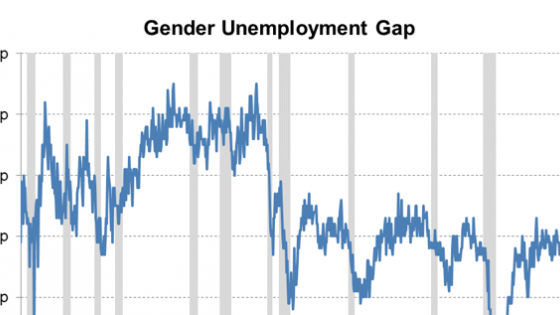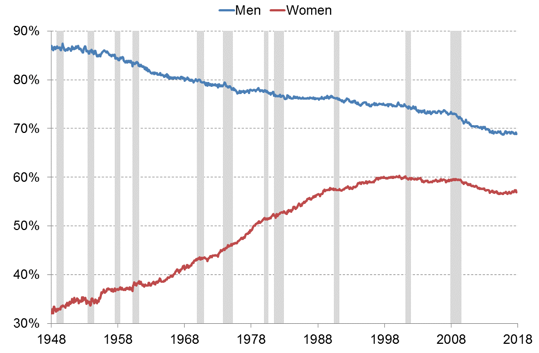One of the most notable developments in the US labour market in the post-war period is the rise of female labour force participation, driven by the behaviour of married women. The female participation rate stabilised at around 60% in the early 1990s. By contrast, the male labour force participation rate steadily declined in the post-war period. After 2009, both the female and male participation rates declined at a similar rate until 2015. The dramatic rise in female participation and the notable decline in male participation have received considerable attention in the literature (Goldin 1990, Goldin and Katz 2002, Autor and Duggan 2003, Greenwood et al. 2005, Olivetti 2006, Albanesi and Olivetti 2016). The flattening of female participation since the early 1990s is more puzzling, though recent research has provided complementary explanations (Fogli and Veldkamp 2011, Blau and Kahn 2013, Fernandez 2013, Albanesi and Prados 2014, Fortin 2015).
Figure 1 Men’s and women’s labour force participation rates in the US
Notes: Data from the Bureau of Labor Statistics. Shading indicates NBER recessions.
An increase in the labour force participation rate is commonly thought to be associated with a rise in the unemployment rate, since labour force entrants must search for a job. While a temporary rise in participation may be associated with an increase the unemployment rate in the short run, it is not clear why the unemployment rate should rise in response to a trend increase in participation. If participation rises due to an increase in labour force attachment, workers become less likely to enter unemployment and consequently the unemployment rate may decline. The converse would hold for a trend decline in the labour force participation rate. The sizable changes in the participation behaviour of women and men in the post-war period provide an ideal setting to examine the relationship between labour force participation and unemployment over a long horizon. We address this question in our recent paper (Albanesi and Şahin 2017).
Figure 2 US unemployment rates
Notes: Data from the Bureau of Labor Statistics. Shading indicates NBER recessions.
Figure 3 US gender unemployment gap
Notes: Data from the Bureau of Labor Statistics. Shading indicates NBER recessions.
Focusing on the US, the gender unemployment gap – defined as the difference between the female and male unemployment rates – was positive until 1983, though the gap tended to close during periods of high unemployment, as Figure 3 shows. After the early 1980s, the gender unemployment gap virtually disappeared, except during recessions, when unemployment among men typically exceeds that among women. This phenomenon was particularly pronounced during the Great Recession from 2007 to 2009. This pattern is consistent with a negative relationship between labour force participation and the unemployment rate.
We first examine whether changes in the composition of the labour force explain the evolution of the gender unemployment gap. Compositional changes are potentially important over this time period, as women’s educational attainment increased rapidly relative to men’s over this period, and the age of women in the labour force increased due to a rise in their employment tenure stemming from the stronger labour market attachment. Additionally, there are sizable differences in the industry and occupational distribution by sex, though these have been slowly declining over the last four decades. We find that these factors have only minor effects on the evolution of the gender unemployment gap, suggesting that compositional changes are not the main determinant of the convergence of unemployment rates by gender. Instead, we show that rising attachment to the labour force of women and declining attachment for men are the main drivers of the closing of the gender unemployment gap.
Our analysis is based on a three-state quantitative search model of the labour market in the spirit of Krusell et al. (2010, 2011, 2017), where women and men experience shocks to their opportunity costs of working that may lead them to leave the labour force. A positive gender unemployment gap in the model arises if the arrival rate and the size of these shocks is higher for women than for men. We calibrate the model to 1978 data to capture a moment in which women’s labour force attachment was weak. We then recalibrate the model to 1996, when unemployment rates by gender had converged and female participation had reached its plateau. The 1996 calibration adjusts for changes in the composition of the female labour force by education, as well as changes in the skill premium and separation rates that occurred between 1978 and 1996. In addition, it targets female and male labour force participation rates, while unemployment rates by gender are determined endogenously. Our 1996 calibration captures virtually all of the changes in the gender unemployment gap from 53% in 1978 to 7% in 1996. The rise in female attachment and the decline in male attachment equally contribute to the convergence in the unemployment rate.
Our framework can also be used to address the implications of the recent decline in the labour force participation rate between 2009 and 2015 on the unemployment rate. While there was a vocal debate on the causes of this decline, most observers agreed that this decline in participation drove at least part of the decline in the unemployment rate over the same period. Our findings raise doubts about this interpretation, and we can use our quantitative framework to shed light on this issue. To do so, we calibrate our model to 2009, matching the gender-specific unemployment and labour force participation rates, as well as all the changes in demographics. Then, we adjust parameters to induce a 3 percentage point decline in both female and male labour force participation, which is in line with the 2.8 percentage point decline from 2009 to 2015. We find that a 3 percentage point reduction in participation causes a 0.1 percentage point increase in the aggregate unemployment rate. Over the same period, the unemployment rate declined from 9.3% to 5.3%. Our analysis suggests that this drop would have been larger without the decline in labour force participation.
International evidence
Our analysis also has implications for cross-country patterns, which we examine using data on labour force participation and the unemployment rate by gender for a group of 21 advanced OECD countries, starting in 1970. First, countries with lower labour force participation gaps, on average, should also exhibit lower unemployment gaps.
Figure 4 The gender gap
Note: Data from the OECD.
Figure 4 displays the average percentage gender gap in labour force participation, defined as the male minus female difference in the participation rate over the male rate, and the average percentage gender unemployment gap, given by the female minus male difference in the unemployment rate over the male rate, for 21 OECD countries. There is a clear positive relationship, with a correlation between the participation and unemployment gender gaps of 0.53, consistent with the first cross-country implication of our analysis. In the paper, we also show that countries that have experienced more convergence in labour force participation rates also experience stronger convergence in unemployment rates as predicted by our framework, suggesting that international evidence broadly supports our hypothesis.
Business cycles implications
Differences in industry distribution do not affect the trend in the gender unemployment gap; however, as we will show, they do play an important role in the cyclical variation of this gap. Men are more likely to be employed in manufacturing and construction, which are very cyclical industries, making them more likely to flow into unemployment during recessions, as shown in Şahin et al. (2009). To quantify the role of gender differences in industry distribution, we calculate the change in employment during recessions, starting with the 1969-1970 cycle. We then construct a counterfactual in which we attribute to women the same industry distribution as men, and compute the corresponding change in employment in each recession and compare it to the actual. As shown in the figure below, the differences in the industry distribution account for nearly all of the gender differences starting with the 1990-1992 recession. However, in early cycles, even with the male industry distribution, women’s employment falls a lot less than that of men. This pattern may be driven by the fast rise in female participation over this period. Albanesi et al. (2012) and Albanesi (2017) show that rising female participation was associated with negligible declines in female employment during recessions and very dramatic increases in employment during recoveries. When female participation stopped rising, the cyclical pattern of employment became very similar for men and women, except for the fact that the decline in employment is larger for men.
Figure 5 Actual and counterfactual employment changes
Note: Data from the Bureau of Labor Statistics.
This analysis sheds light on a question that was hotly debated during the Great Recession. The decline in employment during the recession was larger for men than for women, to the point that in late 2009, women briefly made up more than half of the work force in the US. This drew a lot of attention from the media,[1] leading observers to ask whether the Great Recession was in fact a ‘man-cession’. While the decline in employment for men during the Great Recession may have been particularly severe following the housing crisis, our results suggest that the Great Recession was not unusual in terms of the gender difference in employment behaviour.
References
Albanesi, S (2017), “Changing Business Cycles in the U.S.: The Role of Women’s Employment”, manuscript, University of Pittsburgh.
Albanesi, S and C Olivetti (2016), “Gender Roles and Medical Progress”, The Journal of Political Economy 124(3): 650-695.
Albanesi, S and M J Prados (2012), “Slowing Women’s Labor Force Participation: The Role of Rising Income Inequality”, manuscript, University of Pittsburgh.
Albanesi, S and A Şahin (2017), "The Gender Unemployment Gap," NBER Working Papers No. 23743
Albanesi, S, A Şahin and J Abel (2012), “Reconciling Contrasting Signals in the Labor Market: The Role of Participation”, Liberty Street Economics.
Autor, D and M Duggan (2003), “The Rise in the Disability Rolls and the Decline in Unemployment”, The Quarterly Journal of Economics.
Blau, Francine and Lawrence Kahn. 2013. “Female Labor Supply: Why Is the United States Falling Behind?” American Economic Review 118(1): 157-206.
Fernandez, R (2013), “Cultural Change as Learning: The Evolution of Female Labor Force Participation over a Century”, American Economic Review 103(1): 472-500.
Fogli, A and L Veldkamp (2011), “Nature or Nurture? Learning and the Geography of Female Labor Force Participation”, Econometrica 79(4): 1103-1138.
Fortin, N M (2015), “Gender Role Attitudes and Women’s Labor Market Participation: Opting-Out, AIDS, and the Persistent Appeal of Housewifery”, Annals of Economics and Statistics 117/118: 379-401.
Goldin, C (1990), Understanding the Gender Gap: An Economic History of American Women, New York: Oxford University Press.
Goldin, C and L Katz (2002), “The Power of the Pill: Oral Contraceptives and Women’s Career and Marriage Decisions”, The Journal of Political Economy 110(4): 730-770.
Greenwood, J, A Seshadri and M Yorukoglu (2005), “Engines of Liberation”, The Review of Economic Studies 72(1): 109-133.
Krusell, P, T Mukoyama, R Rogerson and A Şahin (2010), “Aggregate Labor Market Outcomes: The Role of Choice and Chance”, Quantitative Economics 1(1): 97-127.
Krusell, P, T Mukoyama, R Rogerson, and A Şahin (2011), “A Three-State Model of Worker Flows in General Equilibrium”, Journal of Economic Theory 146(3): 1107-1133.
Krusell, P, T Mukoyama, R Rogerson, and A Şahin (2017), “Gross Worker Flows over the Business Cycle”, American Economic Review 107(11): 3447-3476.
Olivetti, C (2006), “Changes in women’s hours of market work: The role of returns to experience”, Review of Economic Dynamics 9(4): 557-587.
Şahin, A, J Song and B Hobijn (2009), “The Unemployment Gender Gap During the 2007 Recession”, Current Issues in Economics and Finance 16(2).
Endnotes
[1] See articles from The Economist and The New York Times.









